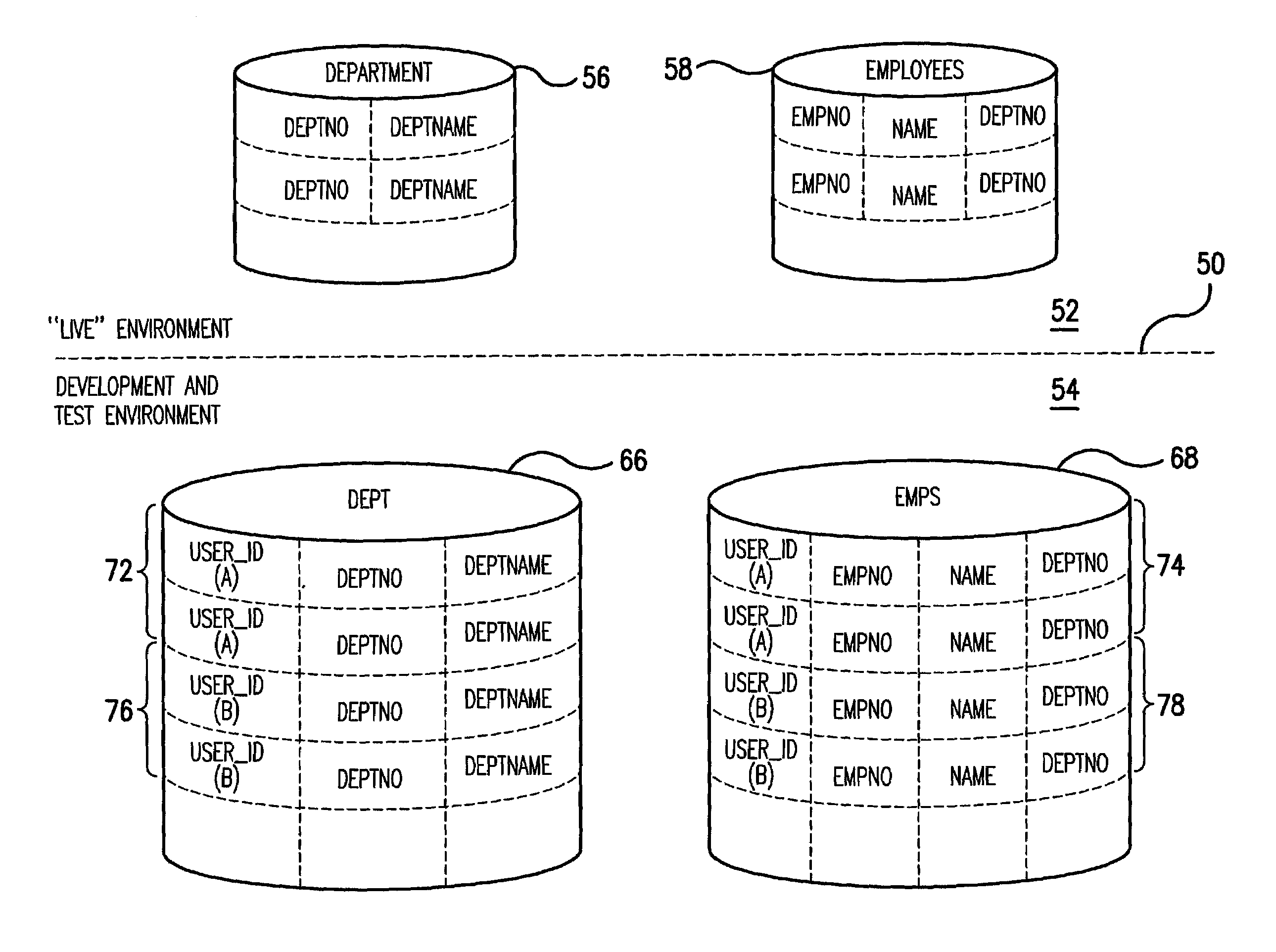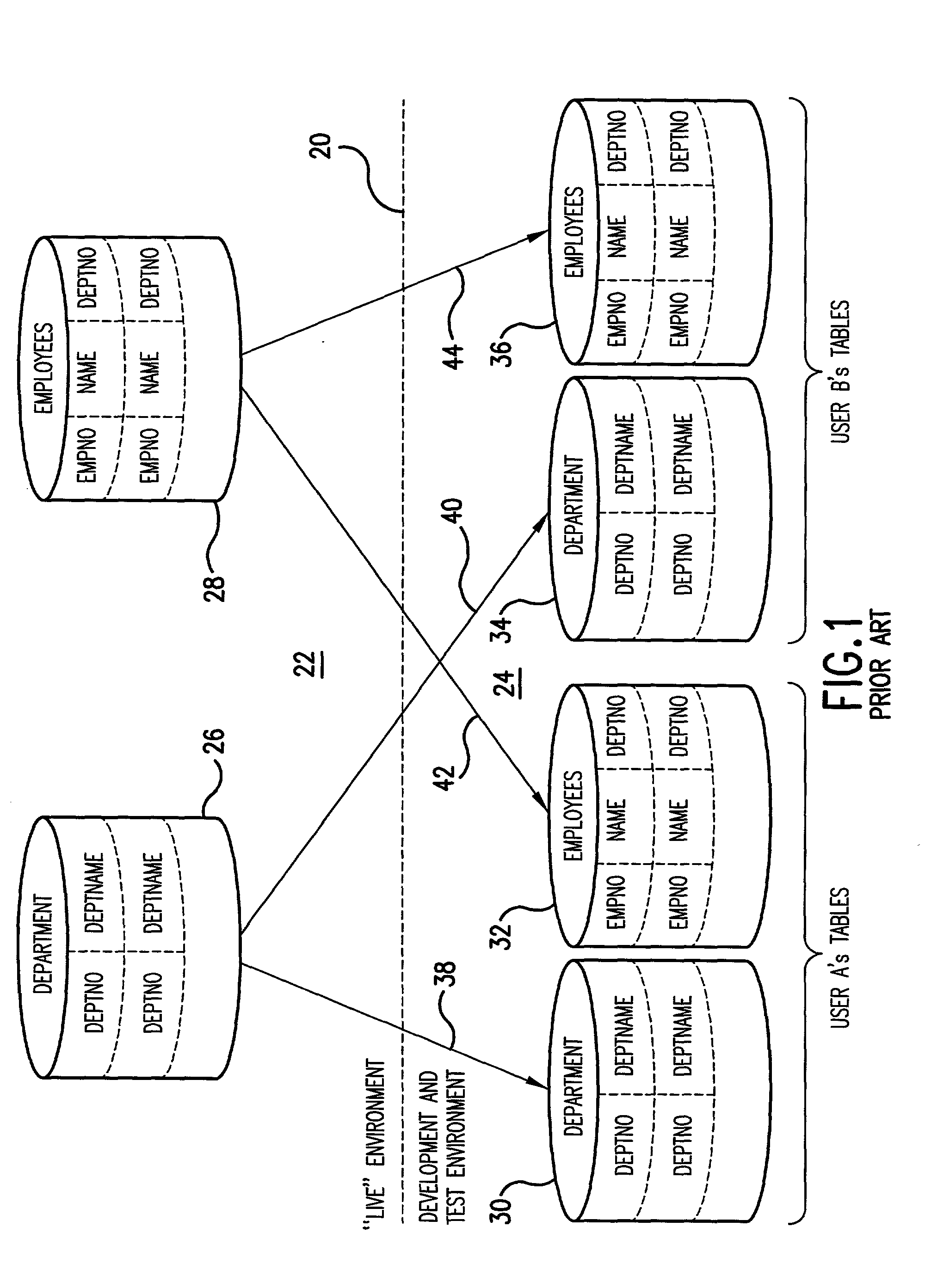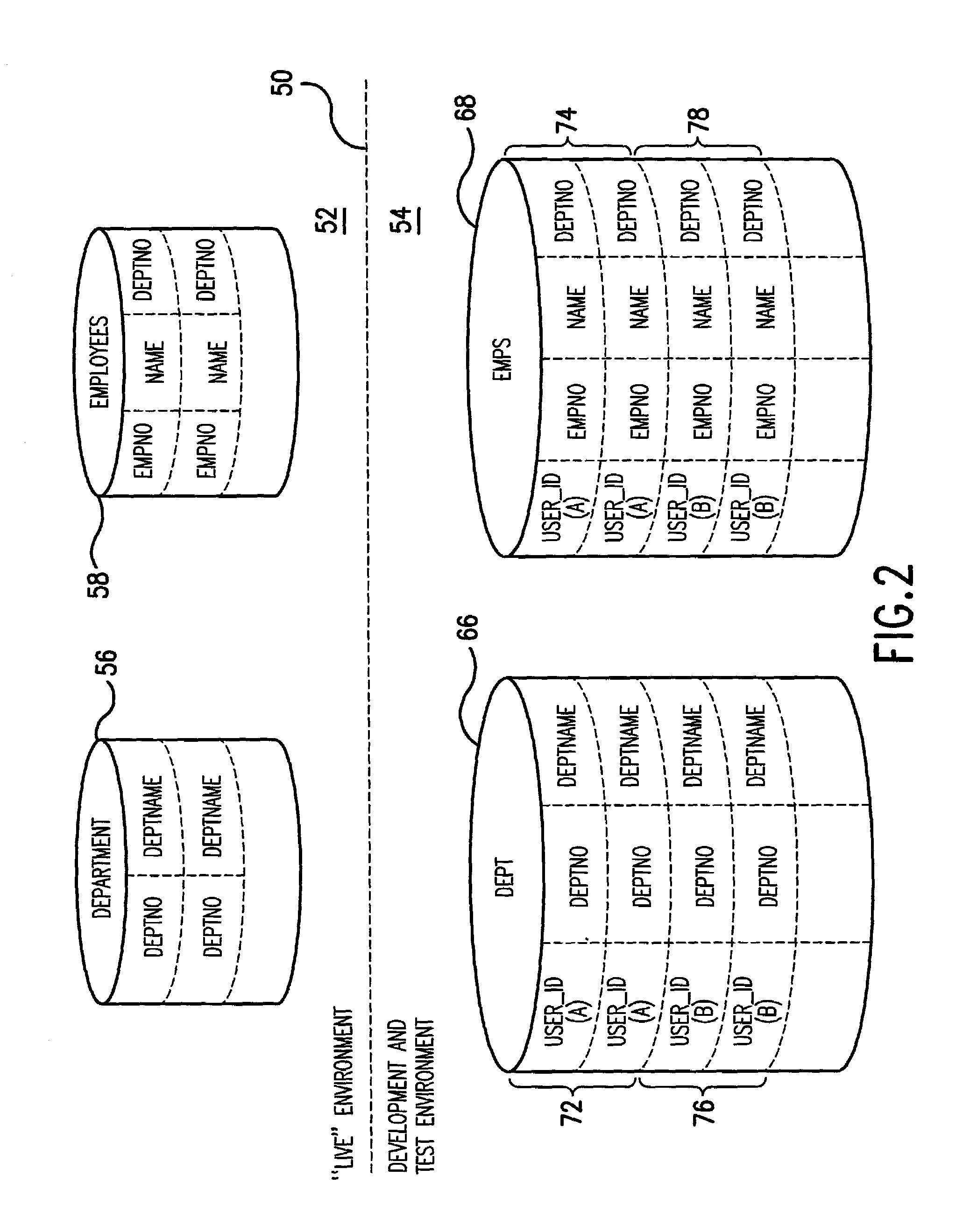Method for facilitating development and testing of relational database application software
a technology for relational database applications and software, applied in relational databases, program control, instruments, etc., can solve the problems of varying degrees of complexity of processes, large data storage capacity, complex databases, etc., and achieve the effect of facilitating development and testing
- Summary
- Abstract
- Description
- Claims
- Application Information
AI Technical Summary
Benefits of technology
Problems solved by technology
Method used
Image
Examples
example 1
[0032]
CREATE TABLE TS3EMP.DEPARTMENT(DEPTNOCHAR(3) NOT NULL,DEPTNANEVARCHAR (38)NOT NULL,MGRNOCHAR (6),ADMRDEPTCHAR (3)NOT NULL,LOCATIONCHAR (16),PRIMARY KEY (DEPTNO) ) IN TDBEMP01.S01 CCSID EBCDIC;CREATE UNIQUE INDEX TS3EMP.XDEPT1 ON TS3EMP.DEPARTMENT(DEPTNO ASC) USING STOGROUP TEMPIX01PRIQTY 12 ERASE NOCLUSTERBUFFERPOOL BP0 CLOSE NO;
[0033]In the foregoing EXAMPLE 1, the DEPARTMENT table created, unlike the simplified example of FIG. 1, actually has five columns defined, namely, DEPTNO, DEPTNAME, MGRNO, ADMRDEPT and LOCATION. The primary key is based on the DEPTNO column only. Also, the creator TS3EMP is specified. (Table names are unique by their creator (sometimes referred to as owner) and their name. (The name before the dot is the creator and the name after the dot is the name of the table.) Usually, but not always, the creator is used for multiple versions of the same table. So, in a development and test environment, one could have for example one hundred invoice tables all ...
example 2
[0044]
CREATE TABLE TS3EMP.DEPT(DEPTNOCHAR (3)NOT NULL,SQL—USERCHAR (08)NOT NULL WITHDEFAULTCURRENT SQLID,DEPTNANEVARCHAR (36)NOT NULL,MGRNOCHAR (6),ADMRDEPTCHAR (3)NOT NULL,LOCATIONCHAR (16),PRIMARY KEY (SQL—USER,DEPTNO) ) IN TDBEMP01.S01 CCSID EBCDIC;CREATE UNIQUE INDEX TS3EMP.XDEPT1 ON TS3EMP.DEPT(SQL—USER, DEPTNO ASC) USING STOGROUP TEMPIX01PRIQTY 12 ERASE NOCLUSTERBUFFERPOOL BP0 CLOSE NO;COMMENT ON TABLE TS3EMP.DEPT IS ‘DEPARTMENT’;CREATE VIEW TS3EMP.DEPARTMENT (DEPTNO,DEPTNAME,MGRNO,ADMRDEPT,LOCATION) AS SELECTDEPTNO,DEPTNAME,MGRNO,ADMRDEPT,LOCATIONFROM TS3EMP.DEPTWHERE SQL—USER = CURRENT SQLIDWITH CHECK OPTION;
[0045]In the foregoing EXAMPLE 2, the new DEPT database table created, unlike the simplified example of FIG. 2, actually has six columns defined, namely, DEPTNO, SQL—USER, DEPTNAME, MGRNO, ADMRDEPT and LOCATION. Thus, compared to the prior art example of EXAMPLE 1, there is an additional column named SQL—USER. The primary key is based on a combination of the SQL—USER and...
example 3
[0057]
CREATE TABLE TS3EMP.DEPT(DEPTNOCHAR (3)NOT NULL,DEPTNAMEVARCHAR (36)NOT NULL,MGRNOCHAR (6),ADMRDEPTCHAR (3)NOT NULL,LOCATIONCHAR (16),PRIMARY KEY (DEPTNO) ) IN TDBEMP01.S01 CCSID EBCDIC;CREATE UNIQUE INDEX TS3EMP.XDEPT1 ON TS3EMP.DEPT(DEPTNO ASC) USING STOGROUP TEMPIX01PRIQTY 12 ERASE NOCLUSTERBUFFERPOOL BP0 CLOSE NO;CREATE VIEW TS3EMP.DEPARTMENT(DEPTNO,DEPTNANE,MGRNO,ADMRDEPT,LOCATION) AS SELECTDEPTNO,DEPTNANE,MGRNO,ADMRDEPT,LOCATIONFROM TS3EMP.DEPT;
[0058]With either the first or second approach, an application program (using DML) developed using the view is guaranteed to work the same when applied to the original database tables. Modification of program source code is not required.
[0059]In view of the foregoing, it will be appreciated that, during development and testing of a database application program by a plurality of individual user entities, each slice is completely isolated from the activities of other user entities, and this isolation is achieved without modificatio...
PUM
 Login to View More
Login to View More Abstract
Description
Claims
Application Information
 Login to View More
Login to View More - R&D
- Intellectual Property
- Life Sciences
- Materials
- Tech Scout
- Unparalleled Data Quality
- Higher Quality Content
- 60% Fewer Hallucinations
Browse by: Latest US Patents, China's latest patents, Technical Efficacy Thesaurus, Application Domain, Technology Topic, Popular Technical Reports.
© 2025 PatSnap. All rights reserved.Legal|Privacy policy|Modern Slavery Act Transparency Statement|Sitemap|About US| Contact US: help@patsnap.com



